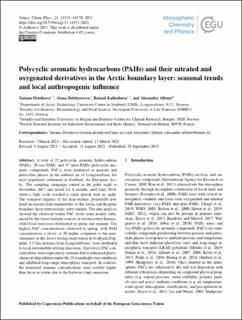| dc.contributor.author | Drotikova, Tatiana | |
| dc.contributor.author | Dekhtyareva, Alena | |
| dc.contributor.author | Kallenborn, Roland | |
| dc.contributor.author | Albinet, Alexander | |
| dc.date.accessioned | 2022-03-29T12:11:50Z | |
| dc.date.available | 2022-03-29T12:11:50Z | |
| dc.date.created | 2021-09-28T09:13:00Z | |
| dc.date.issued | 2021 | |
| dc.identifier.citation | Atmospheric Chemistry and Physics (ACP). 2021, 21 (18), 14351-14370. | |
| dc.identifier.issn | 1680-7316 | |
| dc.identifier.uri | https://hdl.handle.net/11250/2988372 | |
| dc.description.abstract | A total of 22 polycyclic aromatic hydrocarbons(PAHs), 29 oxy-PAHs, and 35 nitro-PAHs (polycyclic aro-matic compounds, PACs) were measured in gaseous andparticulate phases in the ambient air of Longyearbyen, themost populated settlement in Svalbard, the European Arc-tic. The sampling campaign started in the polar night inNovember 2017 and lasted for 8 months until June 2018,when a light cycle reached a sunlit period with no night.The transport regimes of the near-surface, potentially pol-luted air masses from midlatitudes to the Arctic and the polarboundary layer meteorology were studied. The data analysisshowed the observed winter PAC levels were mainly influ-enced by the lower-latitude sources in northwestern Eurasia,while local emissions dominated in spring and summer. Thehighest PAC concentrations observed in spring, with PAHconcentrations a factor of 30 higher compared to the mea-surements at the closest background station in Svalbard (Zep-pelin, 115 km distance from Longyearbyen), were attributedto local snowmobile-driving emissions. The lowest PAC concentrations were expected in summer due to enhanced photochemical degradation under the 24 h midnight sun conditions and inhibited long-range atmospheric transport. In contrast, the measured summer concentrations were notably higher than those in winter due to the harbour (ship) emissions. | |
| dc.language.iso | eng | |
| dc.relation.uri | https://acp.copernicus.org/articles/21/14351/2021/ | |
| dc.subject | Miljøgifter i Arktis | |
| dc.subject | Environmental pollutants in the Arctic | |
| dc.title | Polycyclic aromatic hydrocarbons (PAHs) and their nitrated and oxygenated derivatives in the Arctic boundary layer: Seasonal trends and local anthropogenic influence | |
| dc.type | Peer reviewed | |
| dc.type | Journal article | |
| dc.description.version | publishedVersion | |
| dc.source.pagenumber | 14351-14370 | |
| dc.source.volume | 21 | |
| dc.source.journal | Atmospheric Chemistry and Physics (ACP) | |
| dc.source.issue | 18 | |
| dc.identifier.doi | 10.5194/acp-21-14351-2021 | |
| dc.identifier.cristin | 1939471 | |
| cristin.ispublished | true | |
| cristin.fulltext | original | |
| cristin.qualitycode | 2 | |
